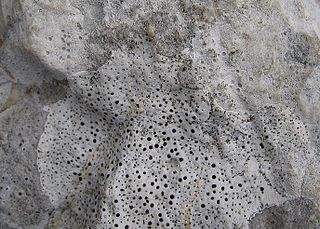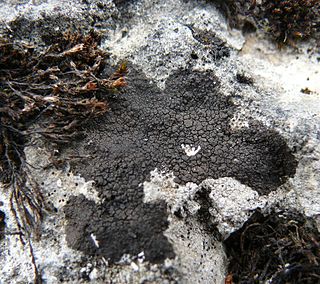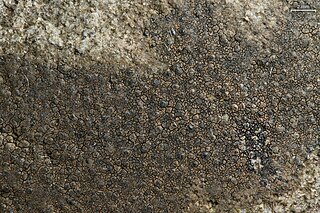
Basidiolichens are lichenized members of the division Basidiomycota within the subkingdom Dikarya of the kingdom Fungi. They form a diverse yet much smaller group of lichens than the far more common ascolichens of the division Ascomycota. Owing to how few described species there are, basidiolichens are generally considered to be poorly researched, and few studies that characterize their natural products exist. Biogeographically, basidiolichen species may be distributed in a cosmopolitan manner or more regionally, ranging from arctic and montane habitats to more temperate and tropical environments. Morphologically, basidiocarp and thallus structures may vary widely within and between basidiolichen genera.

Verrucariales is an order of ascomycetous fungi within the subclass Chaetothyriomycetidae of the class Eurotiomycetes. Although most of the Verrucariales are lichenised, the family Sarcopyreniaceae consists of 11 species of lichenicolous (lichen-dwelling) fungi.

Verrucariaceae is a family of lichens and a few non-lichenised fungi in the order Verrucariales. The lichens have a wide variety of thallus forms, from crustose (crust-like) to foliose (bushy) and squamulose (scaly). Most of them grow on land, some in freshwater and a few in the sea. Many are free-living but there are some species that are parasites on other lichens, while one marine species always lives together with a leafy green alga.

Lepidostromatales is an order of fungi in the class Agaricomycetes. It is the only known order of basidiomycete fungi composed entirely of lichenized members. Morphologically, the fruiting bodies of all species are clavarioid. Six species are known, five of which were described within the span of 2007–2013. Due to its morphological similarity to the genus Multiclavula, its isolated phylogenetic position was not understood until quite recently. The photobionts that have been found in association with members of this group are not known to associate with any other types of lichenized fungi.

Hydropunctaria is a genus of saxicolous (rock-dwelling), crustose lichens in the family Verrucariaceae. The genus includes both aquatic and amphibious species, with members that colonise either marine or freshwater habitats. The type species, Hydropunctaria maura, was formerly classified in the large genus Verrucaria. It is a widely distributed species common to littoral zones. Including the type species, five Hydropunctaria lichens are considered marine species: H. adriatica, H. amphibia, H. aractina, H. orae, and H. oceanica.

Willeya is a genus of saxicolous (rock-dwelling), crustose lichens in the family Verrucariaceae. It has 12 species. Most species are found in southeast Asia, although individual representatives are known from Australia, Europe, and North America.

Placidium arboreum, commonly known as the tree stipplescale, is a species of corticolous (bark-dwelling), squamulose (scaley) lichen in the family Verrucariaceae. Placidium arboreum is primarily found in the southeastern United States, but it also has occurrences in the western and northeastern United States, Mexico, the West Indies, Argentina, and Ontario, Canada. In its habitat, it typically grows at the base of hardwood trees, particularly oak species, and can occasionally be found on other tree genera or even over mosses on limestone. Its preferred substrate is the bark of oak trees, and the lichen usually establishes itself in bark crevices.

Mastodia is a genus of lichen-forming fungi in the family Verrucariaceae. It has six species.
Verrucaria oulankaensis is a rare species of saxicolous (rock-dwelling) crustose lichen in the family Verrucariaceae. It is found in north-eastern Finland, where it occurs on calcareous rocks on river shores.
Wahlenbergiella tavaresiae is a species of saxicolous (rock-dwelling), crustose lichen in the family Verrucariaceae. Known from several locations in the San Francisco Bay area of the United States, it is a marine lichen that inhabits intertidal zones, and as such is immersed in seawater on a regular basis. Associated algal species include the red algae Hildenbrandia and Mastocarpus papillatus, and the brown algae Pelvetiopsis and Fucus. Petroderma maculiforme, a brown alga, is the photobiont partner in the lichen.
Agonimia flabelliformis is a species of corticolous (bark-dwelling) lichen in the family Verrucariaceae. Found in Europe, it was scientifically described as new to science in 2011 by Josef Halda, Paweł Czarnota, and Beata Guzow-Krzemińska. The type specimen was collected in the Gratzen Mountains at an altitude of 805 m (2,641 ft), where it was found growing on the bark of a beech tree. The thallus of the lichen consists of finger-like (dactyliform) to coral-like (coralloid) aggregations of goniocysts that form a roundish structure. The species epithet flabelliformis refers to the fan-shaped (flabellate) form of the thallus branches. In addition to Europe, the lichen has also been recorded in eastern North America and the Russian Far East.

Verrucaria viridula is a common and widely distributed species of saxicolous (rock-dwelling), crustose lichen in the family Verrucariaceae. Although it is a somewhat morphologically variable species, two persistent distinguishing characteristics are its relatively large perithecia, which are often curved into a beak, and its large ascospores.
Protothelenella is a genus of fungi in the family Protothelenellaceae. It contains 11 species, some of which form lichens. Protothelenella species have a crustose thallus with spherical to pear-shaped, dark brown to blackish perithecia. Microscopic characteristics of the genus include bitunicate asci with an amyloid tholus, and ascospores that are colourless and contain multiple internal partitions. Some species grow on acidic substrates including rocks, soil, bryophytes, plant detritus or rotten wood. Other species are lichenicolous (lichen-dwelling), growing on species of Solorina, Peltigera, Pseudocyphellaria, or Cladonia.

Hydropunctaria amphibia is a species of saxicolous (rock-dwelling), crustose lichen in the family Verrucariaceae. One of several marine lichens in the genus Hydropunctaria, is widely distributed across Europe, extending from Norway to the Mediterranean and the Iberian coasts, and has a nearly ubiquitous presence along the Catalan coast of Spain. In North America, it is found along the Atlantic Coast from Nova Scotia to the Boston Harbor islands, where its presence in low-pollution areas indicates its potential as a bioindicator for marine lichen community health, and on the west coast in British Columbia, particularly in the Gwaii Haanas's upper littoral fringe. The black, crust-like thallus grows on seashore rocks – both siliceous rocks and limestone – in the lower supralittoral zone, an area also known as the splash zone. Originally described more than two centuries ago as a species of Verrucaria, Hydropunctaria amphibia sets itself apart from other species in Hydropunctaria through the distinct shape of the perithecium apex, which is either flat-topped or scalloped, in contrast to the typically rounded or immersed apex seen in its relatives.
Placidiopsis hypothallina is a species of saxicolous (rock-dwelling) crustose lichen in the family Verrucariaceae, described as a new species in 2002. It is unique within its genus for its thallus primarily composed of a hyphal hypothallus resembling a subiculum found in some non-lichenised ascomycetes. It is found in Brazil and Taiwan.
Cyanoporina is a fungal genus in the division Ascomycota. The relationship of this taxon to other taxa within the division is unknown, and it has not yet been placed with certainty into any class, order, or family. The genus is monospecific, containing the single species Cyanoporina granulosa, a crustose lichen found in West Java, Indonesia.

Saxiloba is a genus of lichen-forming fungi in the family Porinaceae. It comprises three species of saxicolous (rock-dwelling) placodioid lichens, known from disjunct locations in the Caribbean, Hawaii, and Brazil. The genus was circumscribed in 2020 to accommodate species with a distinctive placodioid thallus featuring unique surface patterns and internal crystal structures. Saxiloba lichens are characterised by their flattened, leaf-like thalli with marginal lobes, growing tightly appressed to rock surfaces. They have a complex internal structure, including large crystal clusters embedded within the photobiont layer, which may be an adaptation for light management in their typically shaded habitats.
Pyrenothrix is a small genus of lichen-forming fungi in the family Pyrenotrichaceae. It comprises two species of filamentous lichens, which are organisms formed by a symbiotic relationship between fungi and photosynthetic partners. The genus is characterized by its unique structure, featuring densely arranged filaments composed of cyanobacteria wrapped in fungal threads. Pyrenothrix species form dark greyish-brown growths on various surfaces, with one species found on tree bark and the other on leaves in tropical forests. The genus was circumscribed in 1917 by American scientist Lincoln Ware Riddle, based on specimens collected in Florida. Pyrenothrix is distinguished from other lichens by its intricate cellular structure and reproductive features, including specialized spore-producing structures.
Capronia normandinae is a species of lichenicolous (lichen-dwelling) fungus in the family Herpotrichiellaceae. The fungus was first formally described in 1990 by Rolf Santesson and David Hawksworth. The fungus has been recorded from Papua New Guinea, the Atlantic Ocean, Australasia, Europe, and South America. The fungus parasitises the host lichen Normandina pulchella, after which it is named.
Globosphaeria is a fungal genus that grows on lichens, containing the single species Globosphaeria jamesii. The fungus is characterised by dark, spherical fruiting bodies producing colourless, round spores, and is found growing on the lichen Normandina pulchella. First collected in Tasmania in 1907 but not described until 1990, it was later also discovered in the United States, making it known from just two locations globally. Though initially placed in the Xylariales, the genus is now classified in the order Sordariales, though its exact family placement remains uncertain.
















